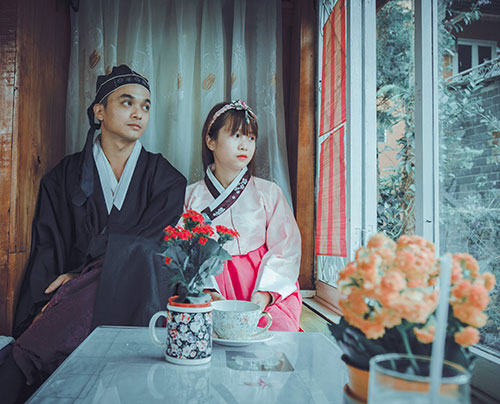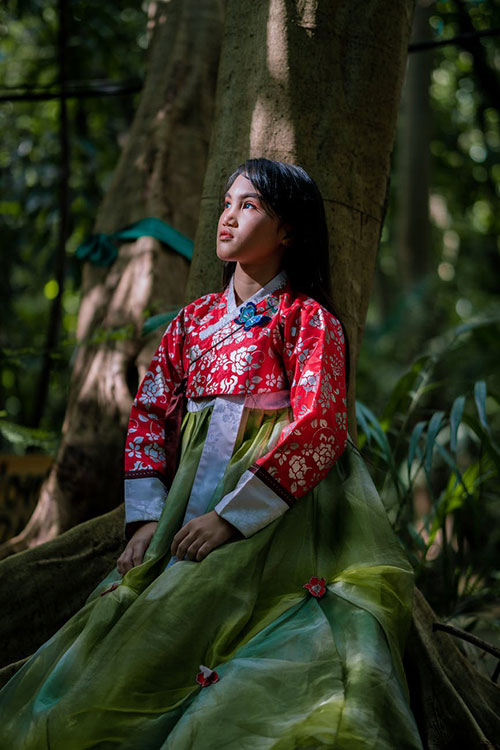 Modern Korean hanbok is very fashionable attire. It is one of the rare traditional outfits that change constantly and is modernized like no other. Most national costumes remain practically the same since the late 19th – early 20th century, but not the Korean hanbok. It even adopted a row of features and innovations from Western-style clothing throughout the last century. For example, originally, Korean folk clothes didn’t have pockets, buttons, or zippers, but today, most modern folk garments are equipped with them. All this makes Korean national attire unique and worth studying because the history of a hanbok teaches us how to modernize the traditional clothes to suit our today’s needs.
Modern Korean hanbok is very fashionable attire. It is one of the rare traditional outfits that change constantly and is modernized like no other. Most national costumes remain practically the same since the late 19th – early 20th century, but not the Korean hanbok. It even adopted a row of features and innovations from Western-style clothing throughout the last century. For example, originally, Korean folk clothes didn’t have pockets, buttons, or zippers, but today, most modern folk garments are equipped with them. All this makes Korean national attire unique and worth studying because the history of a hanbok teaches us how to modernize the traditional clothes to suit our today’s needs.
This article is based on the lecture by Minjee Kim, Korean fashion historian
In Korean culture, there are two words to differentiate traditional costumes from modern Western-style clothing. They call their folk attire the “hanbok” and Western-style clothes the “yangbok”. These terms appeared in the late 19th – early 20th century.

Modern Korean hanbok
What’s interesting about Korean hanbok, is that, unlike most folk garments, it changes constantly even these days. Fashion historians often call traditional dress an anti-fashion attire because it’s the opposite of fashionable clothes – folk garments usually don’t change every year due to new fashion trends, artisans try to make traditional costumes using the same materials and techniques as people did centuries ago, most folk dresses are hand-made, etc. But Korean hanbok is one of those rare traditional outfits that are influenced by fashion. Modern hanboks are absolutely modern garments made from fashionable fabrics according to modern cut and design, with trendy trimmings, and so on. This traditional dress never stopped changing, altering, and transforming. It’s not an anti-fashion item at all.
Korean people, especially Korean women, often buy new hanboks to be fashionable, to look modern and not old-fashioned in their folk clothing. This is probably the only country where you buy new traditional garments all of the time to be fashionable, while usually, you buy just one full traditional ensemble and can wear it for your whole life because it never becomes more outdated than it was when you bought it. Traditional costumes are supposed to be outdated, but not in Korea.

Korean couple in traditional wedding hanboks
And this situation with fashionable hanbok styles isn’t something new for Korea. Throughout its history, the cut, style, and design of hanbok costume changed to suit the period’s fashion trends. For example, at one time in the 18th century, the sleeves of a traditional jeogory jacket became so tight that women couldn’t bend their arms without tearing the seams. Their arms were so tightly squeezed by the sleeves that they got poor blood circulation.
In the 19th century, jeogory jackets became so short that they couldn’t be cropped any shorter. It was literally almost only sleeves joined together.
But the biggest changes in the traditional Korean hanbok began in the late 19th century, when day-to-day Western-style clothing came to Korea and started being used by the locals. These practical ordinary garments influenced the traditional attire a lot. At the time, both an entirely traditional and a modernized hanbok existed at once, depending on what a person wanted – to strictly follow old clothing traditions or to be fashionable. And modernized hanboks turned out to be more enduring and practically forced out gradually the entirely traditional variation of Korean folk dress.
What innovations did Korean hanbok adopt from Western-style clothes?
Modern Korean hanbok adopted a long list of features from European contemporary garments.
Korean male hanbok even adopted a new garment – a Western-style vest. Koreans call it a “jokki”. So, modern men’s hanbok attire consists of baji trousers, a jeogory jacket, a jokki vest, and a magoja outer jacket. The main reason why a European vest became so popular was that it had pockets. Korean traditional clothes never had pockets, instead, they carried small pouches attached to a belt, so when they tried using garments with pockets, they realized how convenient they were. These pockets on vests are called “hojumeoni”, which means “barbarian’s pouch”.
Another significant, life-changing innovation was made to women’s hanbok. Korean female hanbok adopted shoulder straps on a chima skirt. This traditional skirt is a sort of a wrap-around skirt, it is tied at the chest, and it often slips down, which causes inconveniences. So, one American missionary teacher tried to add additional shoulder straps to Korean traditional chima, and this new design became a lot comfier to use. Such shoulder straps came in use in the early 20th century and immediately spread all over the country. Modern hanbok skirts always have these shoulder straps.

Modern Korean hanbok
Also, the silhouette of a hanbok became more of an A-line to resemble crinoline skirts of European women. Even today, this A-line cut still remains popular.
Some other smaller changes to a hanbok were made in the 20th century. The jeogory returned to its classic length (about 14 inches long), a chima skirt became shorter because it was more practical in daily use, etc.
Gradually, a hanbok went out of use as daily clothes. Older people wore it in day-to-day life until about the 1960s. Still, Koreans continued to use hanboks as ceremonial wear, and they do it to this day. And in the 1980s, people in Korea started to rediscover their folk attire and many fashion designers started creating modern hanboks.
In the late 20th – early 21st century, some other significant changes were made to modernize a Korean traditional hanbok. Such modern inventions as knot buttons, zippers, and hooks replaced ties because they are a lot more convenient. Today, male pants are fastened instead of being tied with straps, the ankles are buttoned with knot buttons (while they used to be also tied in a certain complicated way). All these important changes in the traditional outfit help Korean folk dress remain in use and popular till today, the 21st century.


